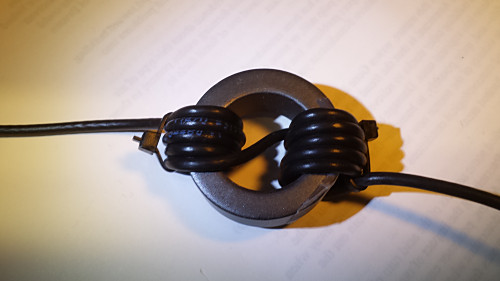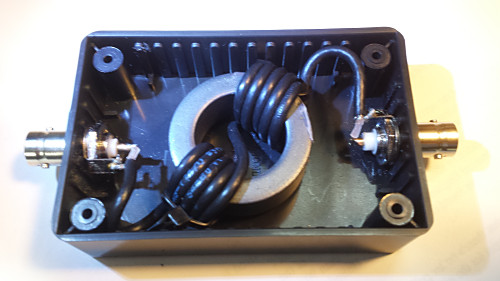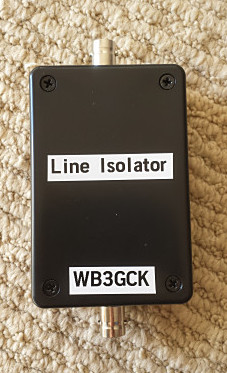One of my favorite portable antennas is a 30-ft wire fed through a 9:1 unun. This type of antenna generally the uses coax feeder as a counterpoise, since the 9:1 unun configuration provides no line isolation. Most of the time, this has worked well for me with no issues with stray RF getting back into the equipment.
On a couple of occasions, my Elecraft T1 auto tuner began to act up, refusing to load up on one or more bands. (Running through the T1’s diagnostic mode always seems to restore operation to normal.) I’ve also had one of my keyers behave erratically once or twice. Since this has only happened when using the 9:1 unun, my suspicion is that common-mode RF currents on the coax shield are the culprit.
My proposed solution for this is to use a line isolator between the tuner and the coax feeder. (Note: Using a line isolator at the antenna end of the coax would defeat the purpose in using the coax as a counterpoise.) A quick survey of my junk box stash of parts showed I had everything I need to build a line isolator from scratch.
Parts List
- RG-174/U coax (approximately 24 inches)
- FT-140-43 ferrite core
- (2) BNC-F chassis mount connectors
- Hammond Manufacturing 1591MSBK Enclosure (2.2 x 3.3 x 0.8 inches)
Construction
This is a very simple project. You can build one in well under an hour.
- The RG-174 coax is wound on the FT-140-43 core for a total of 10 turns. Take note of how the 5th turn goes across the core. This makes installation in the case a little easier. I used a couple of small nylon tie-wraps to hold the windings in place.
- Drill the holes for each of the BNC connectors and wired up the choke, as shown. I used a 5/64-inch drill bit and had to use a reamer to get the holes to the right size for the BNC connectors I used.
- Solder the coax to the BNC connectors.
- To mechanically secure the core, I used a piece of two-sided foam mounting tape to mount the choke to the bottom of the case. As an additional precaution, I put a piece of packing foam on top of the choke before attaching the lid. This foam provides a slight downward pressure on the choke to prevent it from shaking loose in the case during handling.


Testing
I don’t have access to the equipment necessary to do any type of exhaustive testing of the line isolator. In lieu of that, I hooked it up to a 50-ohm dummy load and checked the SWR. It was basically flat from 160M through 6M. While that tells me nothing about how effective it is in reducing common-mode currents, I at least know I didn’t make any serious screw-ups in building it.

In Operation
Well, this part will have to wait until I have a chance to get out for some portable operating. I want to make sure that the line isolator doesn’t affect the T1’s ability to tune my antenna. Since the initial problems were very intermittent, only time will tell if I solved those problems or not. I’ll be sure to update this post with any new insights I gain.
Update 5/16/2017:
Since this article seems to get a lot of traffic, I figured it was time for a long-overdue update. Not long after this post was published, I tested this 1:1 unun in line with the coax to my 30-foot wire and 9:1 unun. As I suspected it might, it affected the tuning of the antenna. One or two bands wouldn’t load up properly. This made sense to me, since this antenna configuration relies on the shield of the coax for the counterpoise. So, there’s some RF on the coax shield by design. This device obviously is blocking some RF, as it should. I haven’t pursued it further and I still have done any measurements to determine its effectiveness. With a change of connectors on the output side, it could definitely be useful as a 1:1 balun, I suppose.
